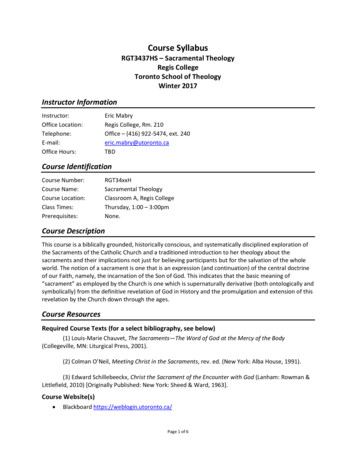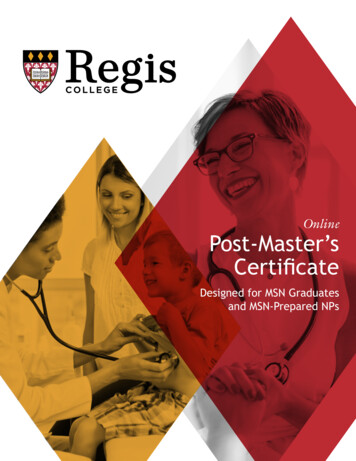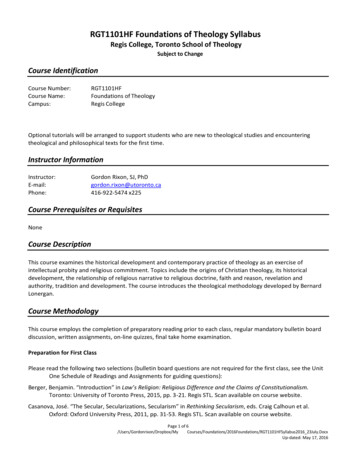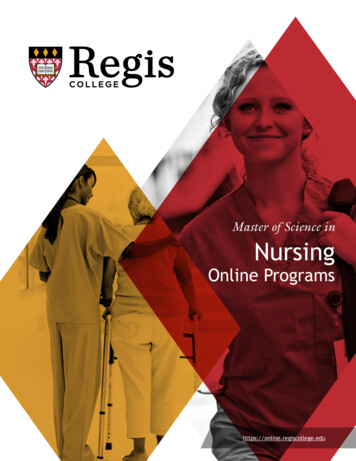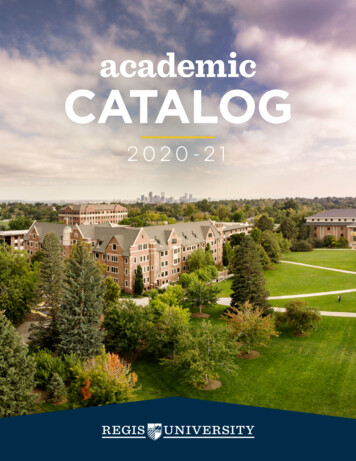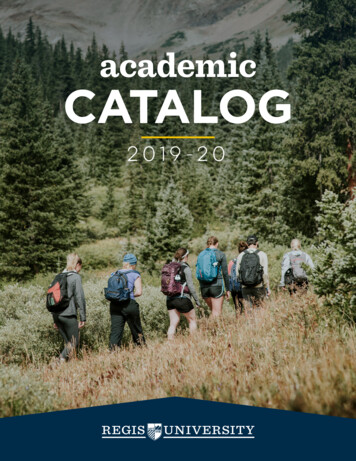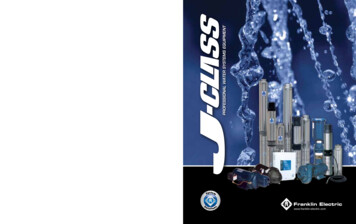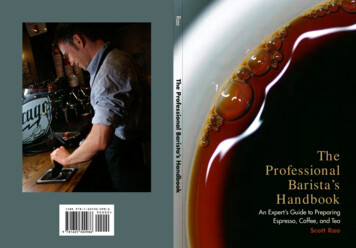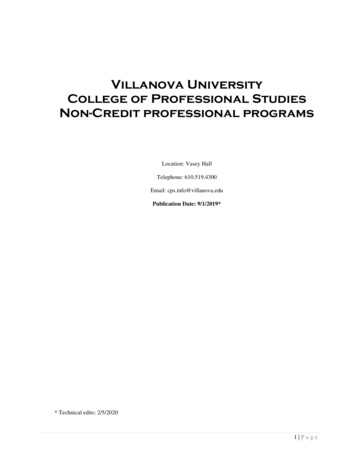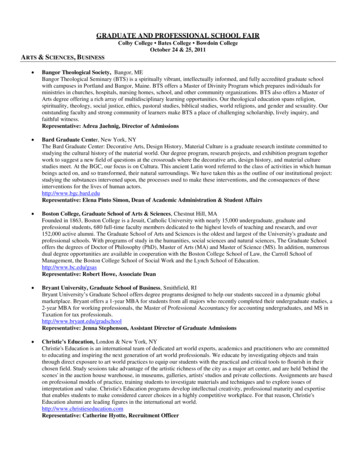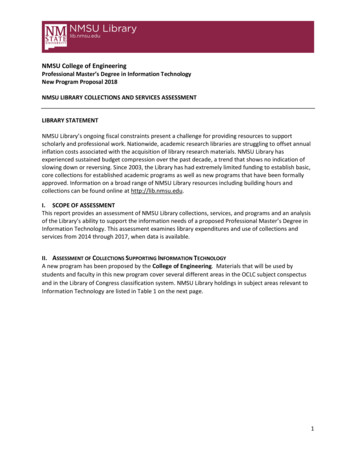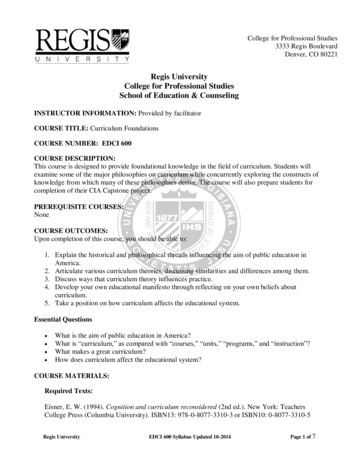
Transcription
College for Professional Studies3333 Regis BoulevardDenver, CO 80221Regis UniversityCollege for Professional StudiesSchool of Education & CounselingINSTRUCTOR INFORMATION: Provided by facilitatorCOURSE TITLE: Curriculum FoundationsCOURSE NUMBER: EDCI 600COURSE DESCRIPTION:This course is designed to provide foundational knowledge in the field of curriculum. Students willexamine some of the major philosophies on curriculum while concurrently exploring the constructs ofknowledge from which many of these philosophies derive. The course will also prepare students forcompletion of their CIA Capstone project.PREREQUISITE COURSES:NoneCOURSE OUTCOMES:Upon completion of this course, you should be able to:1. Explain the historical and philosophical threads influencing the aim of public education inAmerica.2. Articulate various curriculum theories, discussing similarities and differences among them.3. Discuss ways that curriculum theory influences practice.4. Develop your own educational manifesto through reflecting on your own beliefs aboutcurriculum.5. Take a position on how curriculum affects the educational system.Essential Questions What is the aim of public education in America?What is “curriculum,” as compared with “courses,” “units,” “programs,” and “instruction”?What makes a great curriculum?How does curriculum affect the educational system?COURSE MATERIALS:Required Texts:Eisner, E. W. (1994). Cognition and curriculum reconsidered (2nd ed.). New York: TeachersCollege Press (Columbia University). ISBN13: 978-0-8077-3310-3 or ISBN10: 0-8077-3310-5Regis UniversityEDCI 600 Syllabus Updated 10-2014Page 1 of 7
softcover.Hirsch, E. D. (1999). The schools we need and why we don’t have them (reprint ed.). New York:Doubleday (Random House). ISBN13: 978-0-385-49524-0 or ISBN10: 0-385-49524-2 softcover.Flinders, D. J., & Thornton, S. J. (Eds.). (2013). The curriculum studies reader (4th ed.). NewYork: Routledge (Taylor & Francis). ISBN13: 978-0415520751 or ISBN10: 0415520754 softcover.Noddings, N. (2005). The challenge to care in schools: An alternative approach to education (2nded.). New York: Teachers College Press. ISBN10: 0807746096 or ISBN13: 978-0807746097.Perrin, R. (2014). Pocket guide to APA style (5th ed.). Australia: Wadsworth. ISBN-10:128542591X ISBN-13: 978-1285425917.Refer to the Course Assignments and Activities table below for each Topic’s readings and resources.Technology Tools:NoneOptional Materials: Regis Dayton Memorial Library, http://www.regis.edu/library.htmSchool of Education Resources, pxPurdue Online Writing Lab General Writing n/1Family Educational Rights and Privacy Act rpa/index.htmlElectronic Reserves (E-Reserves)eReserves: How to Access or use this link to access the readings: ereserves.regis.edu/ares/.COURSE ASSIGNMENTS AND ACTIVITIES:Topic/WeekTitleReadings 1The Aim ofEducationRegis University Mann, H. (1848). On education and national welfare. http://www.gutenberg.org/ orhttp://www.tncrimlaw.com/civil bible/hora ce mann.htmDewey, J. (1916). Democracy andeducation. http://www.gutenberg.org/ orhttp://www.stephenhicks.org/wp-EDCI 600 Syllabus Updated 10-2014Graded Assignments /Assessmentsand Associated PointsActivity 1: Introduction(Completion required; nopoints)Activity 2: Discussion —Measuring Your BeliefsAgainst Those of Others, 4pointsPage 2 of 7
content/uploads/2011/09/dewey john poe.pdfKwinters. (July 24, 2009). PresidentObama, Secretary Duncan announce race tothe secretary-duncan-announce-race-tothe-top/ orhttps://www.youtube.com/watch?v VNbDv0zPBV4 Accessible .youtube.com/watch?v xsPGVO 4pkwIn Flinders & Thornton, The curriculumstudies reader (4th ed.):Introduction to Part 1National Commission on Excellence inEducation. (1983). A nation at risk: Theimperative for educational /a-nation-at-risk-tenure-april-1983.pdfU.S. Department of Education (2007).Building on results: A blueprint forstrengthening the no child left behind ingonresults.pdfU.S. Department of Education (2011). Ablueprint for reform: The reauthorization ofthe elementary and secondary lueprint/blueprint.pdf tion-at-risk-tenure-april-1983.pdfActivity 3: Written —Creating Your EducationalManifesto, 4 points Activity 1: Discussion —Modern Planning byObjectives, 4 pointsActivity 2: Discussion —NonverbalRepresentations of theModern Curriculum Field,4 points 2“What isCurriculum?”and theCurrent Stateof the FieldRegis UniversityDewey, J. (1902). The child and curricul00deweuoft In Flinders & Thornton, The curriculumstudies reader (4th ed.):o Dewey, J. My pedagogic creed.EDCI 600 Syllabus Updated 10-2014 Page 3 of 7
oooooo 3CoreKnowledge45Activity 3: Written —Reflective or DefinitionalEssay, 24 points Activity 1: Discussion —The Influence ofBehaviorism on CoreKnowledge and Planningby Objectives, 4 pointsActivity 2: Discussion —Core Knowledge RolePlay, 4 points In Flinders & Thornton, Thecurriculum studies reader (4th ed.):o Adler, M. J. The paideiaproposal. (1982)o Noddings, N. The false promiseof the paideia proposal. Eisner, E. W. (1994). Curriculum and cognition reconsidered.Thanasoulas, D. (2002). /linguisticsissues/constructivist.html Duckworth, E. (1996). In The having ofwonderful ideas.http://ereserves.regis.edu/ares/Activity 1: Discussion —NonverbalRepresentations of ArtsBased Curriculum Theory,4 pointsActivity 2: Written —Curriculum TheorySynthesis Essay, 28 pointsAyers, W. (2001). To teach: The journey of a teacher (2nd ed.). Chapter 2.http://ereserves.regis.edu/ares/Noddings: The challenge to care in schools: An alternative approach to education.Chapters 1, 2, 3, and 5.Note: Begin FieldObservation; paper dueWeek 8Activity 1: Discussion —Personal Experience withStudent Centeredness orCare Theory, 4 pointsActivity 2: Discussion —The Big Ideas, 4 points StudentCenterednessand CareTheoryHirsch: The schools we need andwhy we don’t have them. Chapters 1,2, 3, and 7.Boree, C. G. (2006). Personalitytheories: B. F. Skinner: r.html Arts-BasedCurriculumTheoryIntroduction to Part 2Tyler, R. W. Basic principles ofcurriculum and instruction.Greene, M. Curriculum andconsciousness.Introduction to Part 4Doll, W. E. The four R’s – Analternative to tye Tyler rationale.Noddings, N. Curriculum for the 21stcentury. Regis UniversityEDCI 600 Syllabus Updated 10-2014Page 4 of 7
6Ecological andOtherApproaches toEducation 7CRP, SocialJustice, andJesuitCurriculum 8In Flinders & Thornton, The curriculumstudies reader (4th ed.):o Moroye, C. M. Complementarycurriculum: The work of ecologicallyminded teachers.Bowers, C.A. (2005). Educating for asustainable future: Mediating between thecommons and economic globalization.Retrieved May 2013 blefuture.pdfGruenewald, D. A. (2003). The best of bothworlds: A critical pedagogy of place.http://dml.regis.edu/login?url http://edr.sagepub.com/content/32/4/3.full.pdf htmlLadson-Billings, G. (1995). The case forculturally relevant ess.com/2012/03/ladson-billings 1995.pdfIn Flinders & Thornton, The curriculumstudies reader (4th ed.):o Freire, P. Pedagogy of the Oppressed.Tradition: Regis University (2005): Part 3:The Jesuit character of Regis University. InTradition: The Jesuit Catholic university ofthe Rocky Mountain west. (PDF fromwww.regis.edu; search “Tradition Dunphy”) TBD, assigned by facilitator Curriculum inContemporaryEducation Activity 1: Discussion —Environmental andEcological Education, 4pointsActivity 2: IndependentCurriculum ResearchProject, 12Activity 3: Discussion —The Fringe andMainstream of Education,4 pointsActivity 1: Discussion –CRP, Social Justice, andJesuit Curriculum, 4pointsActivity 2: The FieldExperience, The JesuitTradition, and You, 4pointsActivity 3: Written —CRP, Social Justice, andJesuit Themes Paper, 24pointsActivity 1: Share YourField Experience Abstract,4 pointsActivity 2: Written — TheEvolution of YourManifesto, 24 pointsField Experience Paper,72 pointsMAXIMUM POSSIBLEPOINTS 240Regis UniversityEDCI 600 Syllabus Updated 10-2014Page 5 of 7
COLLEGE FOR PROFESSIONAL STUDIES GRADING SCALE:Grading Scale and Equivalent PointsLetterGradeAPercentageGrade Point93 to 1004.00*Minimum CourseEquivalent Points222A–90 to less than 933.67215B 88 to less than 903.33210B83 to less than 883.00198B–80 to less than 832.67191C 78 to less than 802.33186C73 to less than 782.00174C–70 to less than 731.67167D 68 to less than 701.33160D63 to less than 681.00150D–60 to less than 63.67143Less than 600Less than 143FTotal Points in Course240*See Maximum Points from Course Assignments and Activities Table.COLLEGE FOR PROFESSIONAL STUDIES POLICIES (LINKS):You will be asked to enter a valid Regis University UserID and password to access the following policies.Academic Integrityhttp://regis.edu/ .ashxAttendance Confidential Proprietary Information ion%20Policy.pdfDayton Memorial 20Policies/Diversity%20at%20RU.pdfRegis UniversityEDCI 600 Syllabus Updated 10-2014Page 6 of 7
Equal Access and Disability bus%20Policies/Equal%20Access Disability%20Services.pdfHuman Subjects Review nt Weather and Class -Plan/WeatherPolicy.aspxLate or Incomplete Course labus%20Policies/Late%20Assignments Assignment%20Revisions%20Policy%20CPS.pdfLearner us%20Policies/Learner%20Conduct.pdfWriting labus%20Policies/Writing%20Assistance.pdfOTHER INFORMATION:NOTE TO LEARNERS: On occasion, the course facilitator may, at his or her discretion, alter the LearningActivities shown in this Syllabus. The alteration of Learning Activities may not, in any way, change theLearner Outcomes or the grading scale for this course as contained in this syllabus. Examples ofcircumstances that could justify alterations in Learning Activities could include number of learners in thecourse; compelling current events; special facilitator experience or expertise; or unanticipated disruptionsto class session schedule.Regis UniversityEDCI 600 Syllabus Updated 10-2014Page 7 of 7
Regis University EDCI 600 Syllabus Updated 10-2014 Page 4 of 7 o Introduction to Part 2 o Tyler, R. W. Basic principles of curriculum and instruction. o Greene, M. Curriculum and consciousness. o Introduction to Part 4 o Doll, W.
